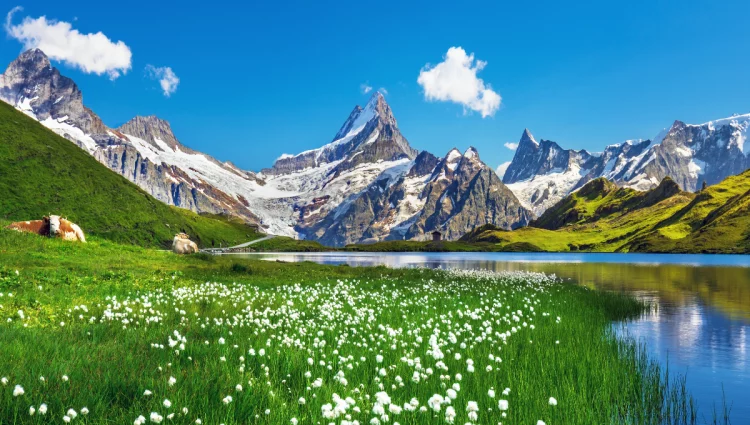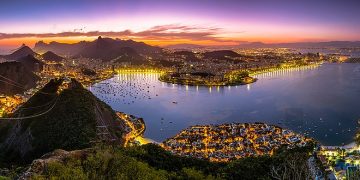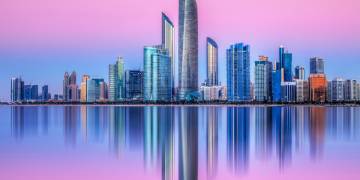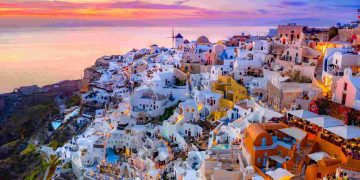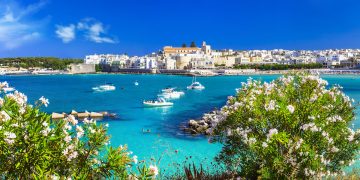The Swiss Alps are one of the most breathtaking and iconic mountain ranges in the world, attracting millions of visitors every year with their awe-inspiring landscapes, serene beauty, and outdoor adventures. Towering peaks, snow-capped mountains, pristine lakes, and picturesque villages come together to create a natural paradise. The region is not only famous for its stunning views, but also for the outdoor activities it offers, making it a top destination for travelers seeking both adventure and tranquility. In this article, we’ll explore the extraordinary beauty of the Swiss Alps, from its majestic peaks to its enchanting valleys, and discover why this natural wonder continues to captivate visitors from around the globe.
1. The Majestic Peaks of the Swiss Alps
The Swiss Alps are home to some of the highest and most spectacular mountains in Europe. These towering peaks, many of which exceed 4,000 meters in height, create an iconic silhouette that defines the landscape of Switzerland. Some of the most famous peaks in the Swiss Alps include The Matterhorn, Mont Blanc, and Dufourspitze.
The Matterhorn
The Matterhorn is perhaps the most recognizable mountain in the world, its pyramid-shaped summit reaching a height of 4,478 meters. Located in the Pennine Alps, near the Italian border, this majestic peak stands as a symbol of the Swiss Alps and Switzerland itself. The Matterhorn is a favorite among mountaineers, though its notoriously challenging climbing conditions make it an accomplishment for only the most experienced climbers.
- Zermatt: The resort town of Zermatt lies at the base of the Matterhorn and serves as a gateway for hikers, skiers, and mountaineers looking to take on this iconic peak. The town is also car-free, which helps preserve the peaceful atmosphere of the area.
- Gorner Glacier: Located near the Matterhorn, the Gorner Glacier offers spectacular views and is one of the largest glaciers in the Alps. It’s a popular destination for hikers, with trails that lead past ice caves and other stunning natural formations.
Mont Blanc
While Mont Blanc is technically located on the border between Switzerland and France, it is still a major attraction for those visiting the Swiss Alps. As the highest mountain in the Alps, Mont Blanc stands at 4,808 meters and offers some of the most spectacular views in the region.
- Chamonix-Mont-Blanc: The French town of Chamonix is a prime starting point for expeditions to Mont Blanc. However, those on the Swiss side of the border can also take a cable car ride to the Aiguille du Midi for an up-close view of the mountain and surrounding glaciers.
- Mont Blanc Tunnel: This tunnel connects the French and Italian sides of Mont Blanc and is one of the world’s longest road tunnels, offering a unique way to explore the mountain range.
Dufourspitze
Dufourspitze, located in the Monte Rosa massif, is the highest peak in Switzerland, reaching 4,634 meters. It offers a challenging climb but rewards adventurers with incredible panoramic views of the Alps. The area around Dufourspitze is a popular destination for experienced mountaineers and trekkers.
2. The Swiss Alps’ Glacial Wonders
The Swiss Alps are also home to an impressive array of glaciers, which add to the majesty of the region. These glaciers not only shape the landscape but also provide visitors with opportunities for glacier hiking, skiing, and ice climbing.
Aletsch Glacier
The Aletsch Glacier is the largest glacier in the Alps, stretching over 23 kilometers in length. This colossal mass of ice is part of the Swiss Alps Jungfrau-Aletsch UNESCO World Heritage site. Visitors to Aletsch Glacier can explore its icy surface and learn about the impact of climate change on glaciers in the region.
- Riederalp: This village offers stunning views of the Aletsch Glacier and serves as an entry point for hikers looking to explore the glacier’s surroundings.
- Ice Climbing: For the adventurous, ice climbing on glaciers such as Aletsch provides an adrenaline-filled way to experience the icy beauty of the Alps.
Gorner Glacier
Located near Zermatt, the Gorner Glacier is another impressive sight in the Swiss Alps. With a length of about 26 kilometers, it’s one of the longest glaciers in Europe. Visitors can take a cable car to Klein Matterhorn, one of the highest cable car stations in the world, for an unforgettable view of the glacier and surrounding mountains.
- Glacier Hiking: Gorner Glacier offers several routes for glacier hiking, including a trail to the Gorner Gorge, where hikers can experience stunning views of the glacier’s edge and surrounding landscape.
- Glacier Paradise: For those looking for a more relaxed experience, the Matterhorn Glacier Paradise offers a scenic cable car ride with spectacular views of the Gorner Glacier and surrounding peaks.
3. Pristine Lakes and Crystal Clear Waters
The Swiss Alps are not only known for their towering mountains and glaciers but also for the stunning lakes that dot the landscape. These crystal-clear waters reflect the beauty of the surrounding mountains, creating picturesque scenery.
Lake Geneva
Lake Geneva, also known as Lac Léman, is one of the largest lakes in Europe and is surrounded by the Alps, providing breathtaking views. The lake is shared by Switzerland and France, with the Swiss cities of Geneva and Montreux offering a beautiful mix of cultural experiences and outdoor activities.
- Geneva: As Switzerland’s second-largest city, Geneva is home to many cultural landmarks, including the Jet d’Eau, one of the world’s tallest fountains. Visitors can take a boat cruise around the lake to enjoy the stunning views of the surrounding Alps.
- Montreux: Famous for the Montreux Jazz Festival, Montreux is a lakeside town that offers a more relaxed atmosphere and is perfect for lakeside strolls or boat rides.
Lake Lucerne
Lake Lucerne is another must-visit destination in the Swiss Alps. Surrounded by dramatic peaks such as Mount Pilatus and Mount Rigi, the lake provides a tranquil setting for visitors to relax and enjoy the natural beauty of the region.
- Lake Cruises: Visitors can take a boat cruise on Lake Lucerne, enjoying the picturesque views of the surrounding mountains and charming lakeside villages.
- Rigi: Known as the “Queen of the Mountains,” Mount Rigi offers panoramic views of the Swiss Alps and is a great spot for hiking and outdoor activities.
Lake Oeschinen
Located near the town of Kandersteg, Lake Oeschinen is often considered one of the most beautiful lakes in Switzerland. With its turquoise waters surrounded by dramatic peaks, this lake is perfect for hiking, boating, and simply enjoying the stunning alpine scenery.
- Hiking Trails: There are several hiking trails that lead to Lake Oeschinen, offering varying levels of difficulty and incredible views of the surrounding mountains and glaciers.
- Boating: During the summer months, visitors can rent small boats and paddle across the lake, soaking in the beautiful alpine landscape.
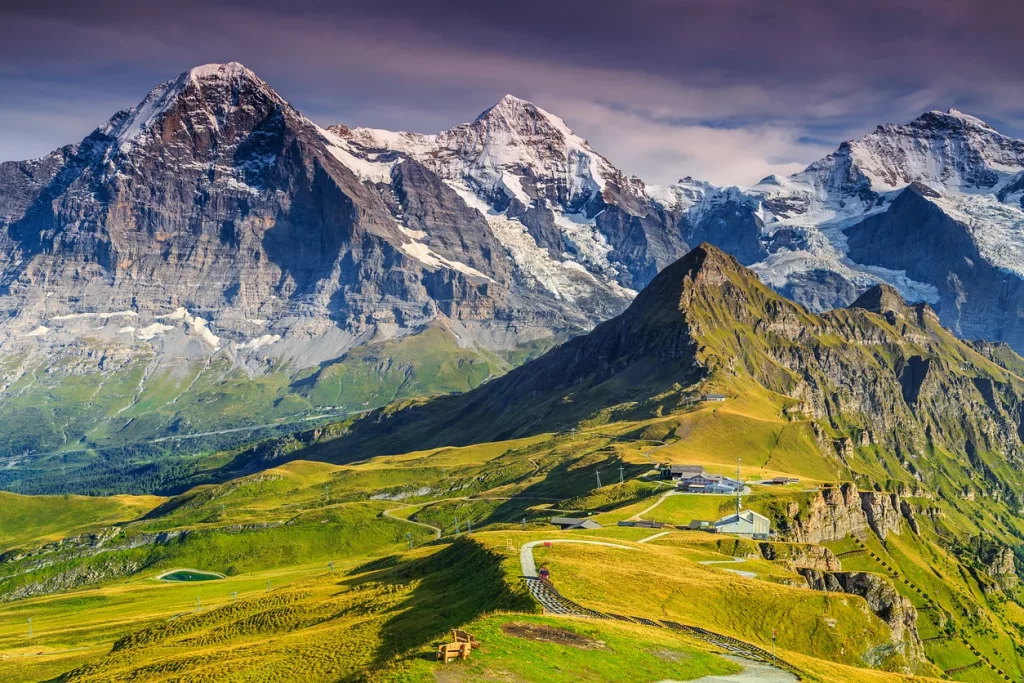
4. Charming Swiss Alpine Villages
In addition to its natural beauty, the Swiss Alps are home to picturesque villages that seem frozen in time. These charming towns offer a glimpse into traditional Swiss mountain life, with their wooden chalets, cobblestone streets, and friendly locals.
Grindelwald
Grindelwald, located in the Jungfrau region, is a quintessential Swiss mountain village that offers stunning views of the surrounding peaks, including the famous Eiger mountain. Grindelwald is a hub for outdoor activities such as hiking, skiing, and mountaineering, but it also offers a peaceful atmosphere for those looking to relax and enjoy the Swiss Alps.
- Grosse Scheidegg: A popular hiking destination, this area offers incredible views of the Eiger, Mönch, and Jungfrau mountains. The hike from Grindelwald to Grosse Scheidegg is a highlight for many visitors.
Zermatt
Zermatt, a car-free resort town at the base of the Matterhorn, is one of Switzerland’s most famous mountain villages. Known for its world-class skiing and mountaineering opportunities, Zermatt also has a cozy, alpine charm with its traditional chalets and a wide variety of restaurants, hotels, and shops.
- Gornergrat Railway: This cogwheel train takes visitors from Zermatt to the Gornergrat summit, offering panoramic views of the Matterhorn and surrounding glaciers.
Lauterbrunnen
Lauterbrunnen is located in a stunning valley surrounded by towering cliffs and dotted with waterfalls. It is one of the most beautiful villages in Switzerland and offers easy access to other scenic destinations such as Jungfraujoch, the “Top of Europe.”
- Trümmelbach Falls: These impressive waterfalls are hidden within the cliffs of Lauterbrunnen Valley, making for an incredible natural spectacle.
5. The Future of the Swiss Alps: Conservation and Sustainability
The Swiss Alps are a fragile environment, and the effects of climate change are becoming more apparent as glaciers melt and weather patterns shift. The region is actively working toward conservation and sustainable tourism practices to protect its delicate ecosystems while continuing to offer visitors access to its natural beauty.
- Sustainable Tourism: Efforts are underway to promote eco-friendly travel, such as reducing carbon emissions, encouraging responsible hiking and skiing practices, and supporting local conservation initiatives.
- Glacier Retreat: Scientists are studying the retreat of the Swiss Alps’ glaciers and the impact this has on the local environment and communities. Visitors are encouraged to be mindful of their environmental impact during their travels.
Conclusion
The Swiss Alps are a true natural wonder, offering some of the most stunning and diverse landscapes in the world. From majestic peaks like the Matterhorn and Mont Blanc to serene lakes like Lake Geneva and Lake Lucerne, the region’s beauty is unrivaled. Whether you’re seeking adventure, relaxation, or a combination of both, the Swiss Alps offer an unforgettable experience for travelers of all types. As the region continues to face challenges from climate change, it’s essential to embrace sustainable travel practices to help preserve the beauty of the Swiss Alps for future generations.


